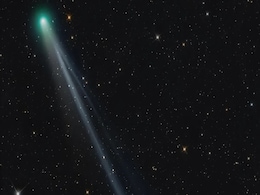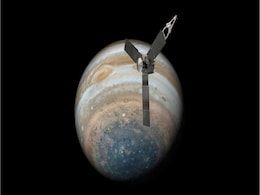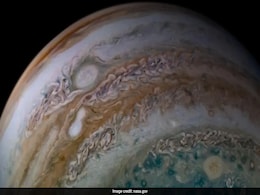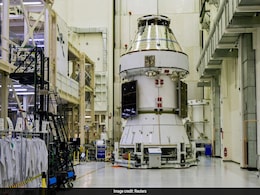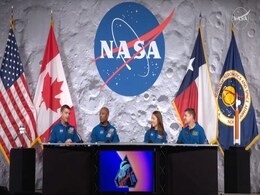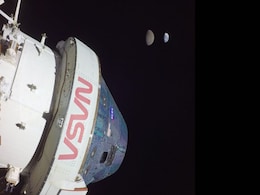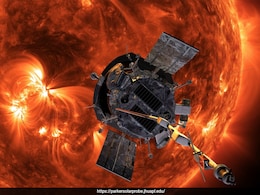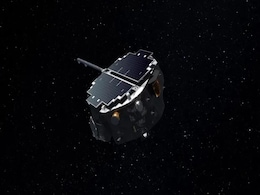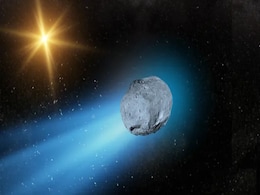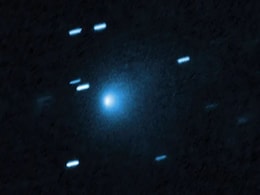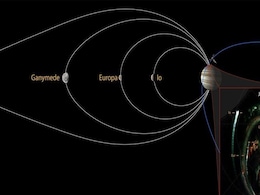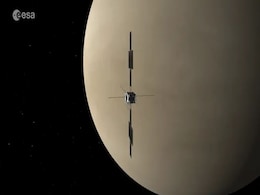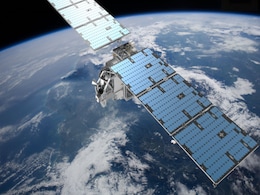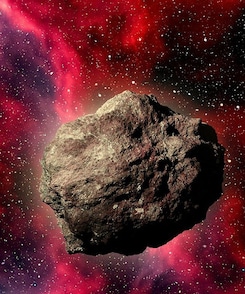Flyby
- All
- News
- Web Stories
-

Mystery Deepens as Interstellar Comet 3I/ATLAS Brightens Unexpectedly Near the Sun
- Thursday November 6, 2025
- Written by Gadgets 360 Staff
Interstellar comet 3I/ATLAS defied expectations during its 2025 solar flyby, brightening far faster than predicted. Observatories worldwide recorded a blue coma rich in exotic gases, suggesting unique chemistry from another star system. Scientists are investigating whether its unusual composition or speed caused the outburst, marking a new interste...
-
 www.gadgets360.com
www.gadgets360.com
-

Solar Wind Cuts Comet Lemmon’s Tail In Rare Disconnection Event
- Wednesday October 15, 2025
- Written by Gadgets 360 Staff
Astrophotographer Brennan Gilmore captured a rare “disconnection event” on Oct. 2, showing solar wind cutting Comet Lemmon’s glowing green ion tail. The comet, nearing its October 2025 flyby, displayed a vivid coma and long tail—revealing how solar activity reshapes comets in real time.
-
 www.gadgets360.com
www.gadgets360.com
-

NASA’s Juno Probe Faces Silence as Mission Ends Amid Government Shutdown
- Tuesday October 7, 2025
- Written by Gadgets 360 Staff
NASA’s Juno probe, orbiting Jupiter since 2016, may have stopped operating after its latest extension expired during the U.S. government shutdown. The mission, which unveiled Jupiter’s interior, polar storms, and moons, awaits confirmation—though NASA cannot verify its status until funding and communications resume.
-
 www.gadgets360.com
www.gadgets360.com
-

NASA's Juno Probe Unlocked Mysteries Of Jupiter, But It May Already Be Dead
- Monday October 6, 2025
- Science | Edited by Srishti Singh Sisodia
The mission was extended until September 2025, allowing for additional orbits and flybys of Jupiter's moons like Ganymede, Europa and Io.
-
 www.ndtv.com
www.ndtv.com
-

Artemis 2 Orion Capsule Named “Integrity” for Upcoming Moon Flyby
- Sunday September 28, 2025
- Written by Gadgets 360 Staff
On Sept. 24, 2025, NASA’s Artemis 2 crew announced their Orion spacecraft will be called Integrity. The name symbolizes trust and respect as four astronauts prepare for a 10-day flight around the Moon, the first crewed lunar mission in over five decades.
-
 www.gadgets360.com
www.gadgets360.com
-

NASA Targets February 2026 Window for Historic Artemis 2 Moon Mission
- Sunday September 28, 2025
- Written by Gadgets 360 Staff
NASA plans its first crewed lunar mission in over 50 years with Artemis 2, possibly launching Feb. 5, 2026. The 10-day flight will carry four astronauts around the Moon to validate deep-space systems and prepare for a lunar landing on Artemis 3.
-
 www.gadgets360.com
www.gadgets360.com
-

Delhi To New York In 1 Minute: NASA's Parker Solar Probe Equals Record Speed
- Monday September 22, 2025
- Science | Edited by Abhinav Singh
The Parker Solar Probe equalled its record-setting speed of 687,000 km per hour that was set during its previous close approaches.
-
 www.ndtv.com
www.ndtv.com
-

Scientists Propose Space Missions to Chase Down Interstellar Comets
- Monday September 15, 2025
- Written by Gadgets 360 Staff
A Southwest Research Institute study reveals that chasing interstellar comets like 3I/ATLAS is achievable with current rockets and instruments. Such missions could collect data on comet nuclei and comae, providing clues to the formation of other star systems. International collaborations make these rare, high-value missions increasingly realistic.
-
 www.gadgets360.com
www.gadgets360.com
-

Scientists Say Missions to Interstellar Comets Like 3I/ATLAS Are Feasible With Existing Tech
- Wednesday September 10, 2025
- Written by Gadgets 360 Staff
A Southwest Research Institute study reveals that chasing interstellar comets like 3I/ATLAS is achievable with current rockets and instruments. Such missions could collect data on comet nuclei and comae, providing clues to the formation of other star systems. International collaborations make these rare, high-value missions increasingly realistic.
-
 www.gadgets360.com
www.gadgets360.com
-

NASA Tracks Newly Discovered Bus-Sized Asteroid as It Flies Past Earth
- Thursday September 4, 2025
- Written by Gadgets 360 Staff
A newly discovered asteroid, 2025 QV5, about the size of a school bus, will safely pass Earth today at a distance of 500,000 miles, roughly twice as far as the moon. NASA’s JPL notes it will not return this close again until September 2125. Scientists are tracking its path to refine orbital predictions and future flybys.
-
 www.gadgets360.com
www.gadgets360.com
-

NASA's Hubble Captures Interstellar Comet 3I/ATLAS Ahead of Close Mars Flyby
- Thursday September 4, 2025
- Written by Gadgets 360 Staff
On October 3, 2025, interstellar comet 3I/ATLAS will pass just 30 million km from Mars — nine times closer than from Earth. ESA’s Mars Express and TGO, along with NASA and China’s orbiters, will attempt to image its coma, analyze gases, and study this rare visitor from beyond the solar system.
-
 www.gadgets360.com
www.gadgets360.com
-

NASA’s Juno Spacecraft Detects Callisto’s Aurora, Completing Jupiter’s Galilean Moons Set
- Wednesday September 3, 2025
- Written by Gadgets 360 Staff
NASA’s Juno spacecraft has captured Callisto’s elusive auroral footprint, completing the “family portrait” of Jupiter’s Galilean moons. Each moon carves its own aurora into the gas giant’s poles, revealing how they interact with Jupiter’s powerful magnetosphere. Callisto’s faint arc appeared during a 2019 flyby, finally confirming i...
-
 www.gadgets360.com
www.gadgets360.com
-

ESA’s JUICE Probe Uses Venus Flyby to Stay on Track for Jupiter’s Icy Moons
- Monday September 1, 2025
- Written by Gadgets 360 Staff
The European Space Agency’s Jupiter Icy Moons Explorer (JUICE) successfully executed a Venus flyby on August 31, 2025, using the planet’s gravity to speed toward Jupiter. Engineers overcame a brief antenna glitch before the maneuver, and the spacecraft endured Venus’s intense heat by shielding itself with its high-gain antenna.
-
 www.gadgets360.com
www.gadgets360.com
-

ESA JUICE Mission Scans Jupiter's Lunar Crater in Test Run for Alien Life
- Tuesday August 5, 2025
- Written by Gadgets 360 Staff
ESA’s JUICE spacecraft scanned the famous Earthrise crater on the Moon to test radar for future exploration of Jupiter’s icy moons. The data confirmed JUICE’s radar accuracy, setting the stage for a search for life beneath Europa and Ganymede. The crater, immortalised in a 1968 Apollo 8 photo, now plays a role in extraterrestrial science.
-
 www.gadgets360.com
www.gadgets360.com
-

Mystery Deepens as Interstellar Comet 3I/ATLAS Brightens Unexpectedly Near the Sun
- Thursday November 6, 2025
- Written by Gadgets 360 Staff
Interstellar comet 3I/ATLAS defied expectations during its 2025 solar flyby, brightening far faster than predicted. Observatories worldwide recorded a blue coma rich in exotic gases, suggesting unique chemistry from another star system. Scientists are investigating whether its unusual composition or speed caused the outburst, marking a new interste...
-
 www.gadgets360.com
www.gadgets360.com
-

Solar Wind Cuts Comet Lemmon’s Tail In Rare Disconnection Event
- Wednesday October 15, 2025
- Written by Gadgets 360 Staff
Astrophotographer Brennan Gilmore captured a rare “disconnection event” on Oct. 2, showing solar wind cutting Comet Lemmon’s glowing green ion tail. The comet, nearing its October 2025 flyby, displayed a vivid coma and long tail—revealing how solar activity reshapes comets in real time.
-
 www.gadgets360.com
www.gadgets360.com
-

NASA’s Juno Probe Faces Silence as Mission Ends Amid Government Shutdown
- Tuesday October 7, 2025
- Written by Gadgets 360 Staff
NASA’s Juno probe, orbiting Jupiter since 2016, may have stopped operating after its latest extension expired during the U.S. government shutdown. The mission, which unveiled Jupiter’s interior, polar storms, and moons, awaits confirmation—though NASA cannot verify its status until funding and communications resume.
-
 www.gadgets360.com
www.gadgets360.com
-

NASA's Juno Probe Unlocked Mysteries Of Jupiter, But It May Already Be Dead
- Monday October 6, 2025
- Science | Edited by Srishti Singh Sisodia
The mission was extended until September 2025, allowing for additional orbits and flybys of Jupiter's moons like Ganymede, Europa and Io.
-
 www.ndtv.com
www.ndtv.com
-

Artemis 2 Orion Capsule Named “Integrity” for Upcoming Moon Flyby
- Sunday September 28, 2025
- Written by Gadgets 360 Staff
On Sept. 24, 2025, NASA’s Artemis 2 crew announced their Orion spacecraft will be called Integrity. The name symbolizes trust and respect as four astronauts prepare for a 10-day flight around the Moon, the first crewed lunar mission in over five decades.
-
 www.gadgets360.com
www.gadgets360.com
-

NASA Targets February 2026 Window for Historic Artemis 2 Moon Mission
- Sunday September 28, 2025
- Written by Gadgets 360 Staff
NASA plans its first crewed lunar mission in over 50 years with Artemis 2, possibly launching Feb. 5, 2026. The 10-day flight will carry four astronauts around the Moon to validate deep-space systems and prepare for a lunar landing on Artemis 3.
-
 www.gadgets360.com
www.gadgets360.com
-

Delhi To New York In 1 Minute: NASA's Parker Solar Probe Equals Record Speed
- Monday September 22, 2025
- Science | Edited by Abhinav Singh
The Parker Solar Probe equalled its record-setting speed of 687,000 km per hour that was set during its previous close approaches.
-
 www.ndtv.com
www.ndtv.com
-

Scientists Propose Space Missions to Chase Down Interstellar Comets
- Monday September 15, 2025
- Written by Gadgets 360 Staff
A Southwest Research Institute study reveals that chasing interstellar comets like 3I/ATLAS is achievable with current rockets and instruments. Such missions could collect data on comet nuclei and comae, providing clues to the formation of other star systems. International collaborations make these rare, high-value missions increasingly realistic.
-
 www.gadgets360.com
www.gadgets360.com
-

Scientists Say Missions to Interstellar Comets Like 3I/ATLAS Are Feasible With Existing Tech
- Wednesday September 10, 2025
- Written by Gadgets 360 Staff
A Southwest Research Institute study reveals that chasing interstellar comets like 3I/ATLAS is achievable with current rockets and instruments. Such missions could collect data on comet nuclei and comae, providing clues to the formation of other star systems. International collaborations make these rare, high-value missions increasingly realistic.
-
 www.gadgets360.com
www.gadgets360.com
-

NASA Tracks Newly Discovered Bus-Sized Asteroid as It Flies Past Earth
- Thursday September 4, 2025
- Written by Gadgets 360 Staff
A newly discovered asteroid, 2025 QV5, about the size of a school bus, will safely pass Earth today at a distance of 500,000 miles, roughly twice as far as the moon. NASA’s JPL notes it will not return this close again until September 2125. Scientists are tracking its path to refine orbital predictions and future flybys.
-
 www.gadgets360.com
www.gadgets360.com
-

NASA's Hubble Captures Interstellar Comet 3I/ATLAS Ahead of Close Mars Flyby
- Thursday September 4, 2025
- Written by Gadgets 360 Staff
On October 3, 2025, interstellar comet 3I/ATLAS will pass just 30 million km from Mars — nine times closer than from Earth. ESA’s Mars Express and TGO, along with NASA and China’s orbiters, will attempt to image its coma, analyze gases, and study this rare visitor from beyond the solar system.
-
 www.gadgets360.com
www.gadgets360.com
-

NASA’s Juno Spacecraft Detects Callisto’s Aurora, Completing Jupiter’s Galilean Moons Set
- Wednesday September 3, 2025
- Written by Gadgets 360 Staff
NASA’s Juno spacecraft has captured Callisto’s elusive auroral footprint, completing the “family portrait” of Jupiter’s Galilean moons. Each moon carves its own aurora into the gas giant’s poles, revealing how they interact with Jupiter’s powerful magnetosphere. Callisto’s faint arc appeared during a 2019 flyby, finally confirming i...
-
 www.gadgets360.com
www.gadgets360.com
-

ESA’s JUICE Probe Uses Venus Flyby to Stay on Track for Jupiter’s Icy Moons
- Monday September 1, 2025
- Written by Gadgets 360 Staff
The European Space Agency’s Jupiter Icy Moons Explorer (JUICE) successfully executed a Venus flyby on August 31, 2025, using the planet’s gravity to speed toward Jupiter. Engineers overcame a brief antenna glitch before the maneuver, and the spacecraft endured Venus’s intense heat by shielding itself with its high-gain antenna.
-
 www.gadgets360.com
www.gadgets360.com
-

ESA JUICE Mission Scans Jupiter's Lunar Crater in Test Run for Alien Life
- Tuesday August 5, 2025
- Written by Gadgets 360 Staff
ESA’s JUICE spacecraft scanned the famous Earthrise crater on the Moon to test radar for future exploration of Jupiter’s icy moons. The data confirmed JUICE’s radar accuracy, setting the stage for a search for life beneath Europa and Ganymede. The crater, immortalised in a 1968 Apollo 8 photo, now plays a role in extraterrestrial science.
-
 www.gadgets360.com
www.gadgets360.com


